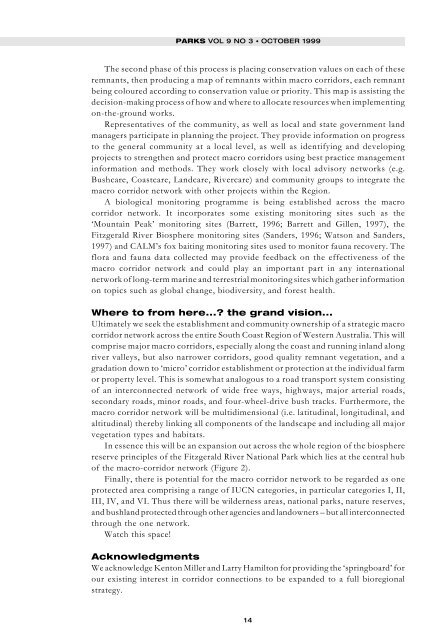Parks - IUCN
Parks - IUCN
Parks - IUCN
You also want an ePaper? Increase the reach of your titles
YUMPU automatically turns print PDFs into web optimized ePapers that Google loves.
PARKS VOL 9 NO 3 • OCTOBER 1999<br />
The second phase of this process is placing conservation values on each of these<br />
remnants, then producing a map of remnants within macro corridors, each remnant<br />
being coloured according to conservation value or priority. This map is assisting the<br />
decision-making process of how and where to allocate resources when implementing<br />
on-the-ground works.<br />
Representatives of the community, as well as local and state government land<br />
managers participate in planning the project. They provide information on progress<br />
to the general community at a local level, as well as identifying and developing<br />
projects to strengthen and protect macro corridors using best practice management<br />
information and methods. They work closely with local advisory networks (e.g.<br />
Bushcare, Coastcare, Landcare, Rivercare) and community groups to integrate the<br />
macro corridor network with other projects within the Region.<br />
A biological monitoring programme is being established across the macro<br />
corridor network. It incorporates some existing monitoring sites such as the<br />
‘Mountain Peak’ monitoring sites (Barrett, 1996; Barrett and Gillen, 1997), the<br />
Fitzgerald River Biosphere monitoring sites (Sanders, 1996; Watson and Sanders,<br />
1997) and CALM’s fox baiting monitoring sites used to monitor fauna recovery. The<br />
flora and fauna data collected may provide feedback on the effectiveness of the<br />
macro corridor network and could play an important part in any international<br />
network of long-term marine and terrestrial monitoring sites which gather information<br />
on topics such as global change, biodiversity, and forest health.<br />
Where to from here...? the grand vision...<br />
Ultimately we seek the establishment and community ownership of a strategic macro<br />
corridor network across the entire South Coast Region of Western Australia. This will<br />
comprise major macro corridors, especially along the coast and running inland along<br />
river valleys, but also narrower corridors, good quality remnant vegetation, and a<br />
gradation down to ‘micro’ corridor establishment or protection at the individual farm<br />
or property level. This is somewhat analogous to a road transport system consisting<br />
of an interconnected network of wide free ways, highways, major arterial roads,<br />
secondary roads, minor roads, and four-wheel-drive bush tracks. Furthermore, the<br />
macro corridor network will be multidimensional (i.e. latitudinal, longitudinal, and<br />
altitudinal) thereby linking all components of the landscape and including all major<br />
vegetation types and habitats.<br />
In essence this will be an expansion out across the whole region of the biosphere<br />
reserve principles of the Fitzgerald River National Park which lies at the central hub<br />
of the macro-corridor network (Figure 2).<br />
Finally, there is potential for the macro corridor network to be regarded as one<br />
protected area comprising a range of <strong>IUCN</strong> categories, in particular categories I, II,<br />
III, IV, and VI. Thus there will be wilderness areas, national parks, nature reserves,<br />
and bushland protected through other agencies and landowners – but all interconnected<br />
through the one network.<br />
Watch this space!<br />
Acknowledgments<br />
We acknowledge Kenton Miller and Larry Hamilton for providing the ‘springboard’ for<br />
our existing interest in corridor connections to be expanded to a full bioregional<br />
strategy.<br />
14

















